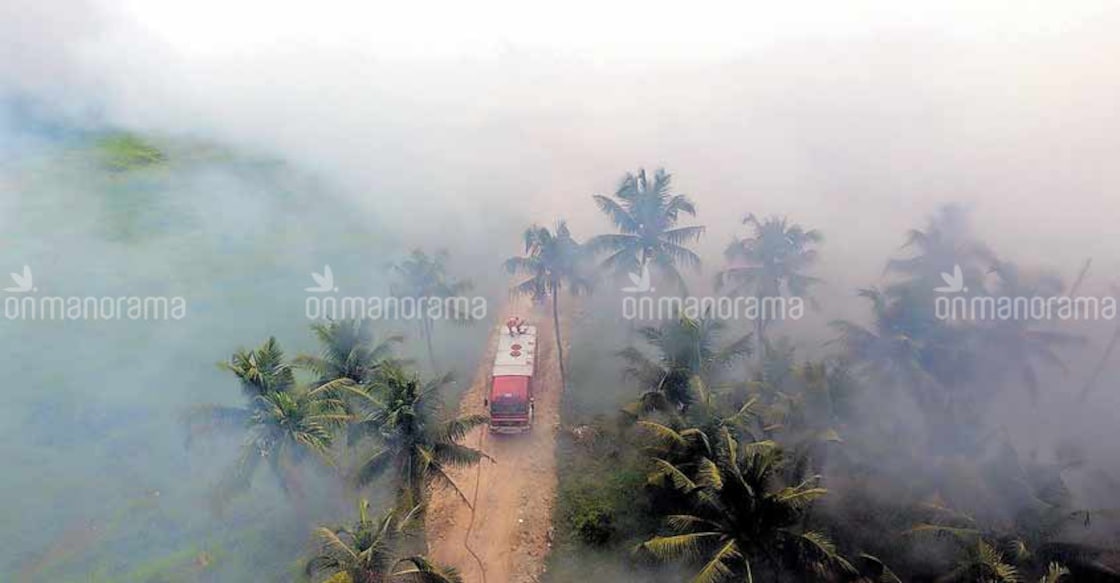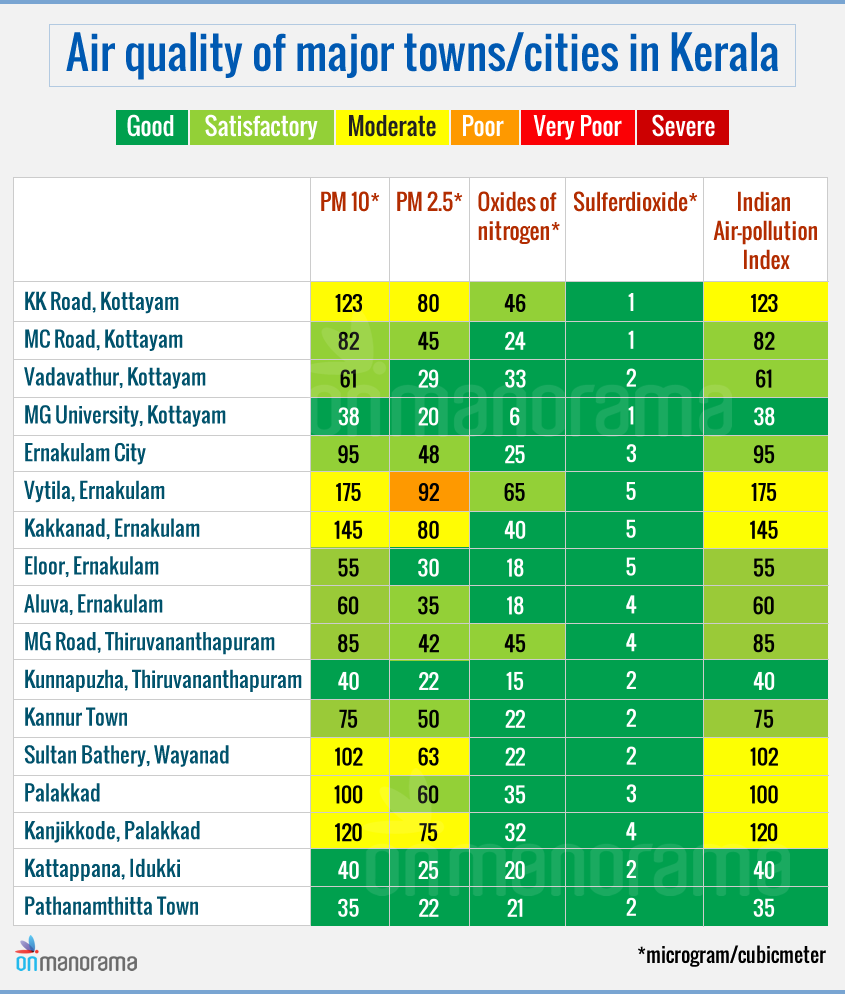Don't wait for Delhi-like pollution disaster, new policy needed for Kerala to breathe easy

Mail This Article
Two years ago 40-year-old Anil Kumar (name changed), a top level employee in a reputed private firm in Delhi, sought a transfer to Kochi in his home state Kerala just to escape from the thick smog that engulfs India's capital every winter.
“I can breathe easy now,” he said after reaching the 'God's own country' in 2017. Anil's two children had developed pollution-related health problems during Delhi winters and finally he also joined the growing contingent of 'pollution refugees'.
Unfortunately for him, he may have to take another transfer out of Kerala if the increasing pollution level in several parts of the state is any indication to the imminent danger awaiting the beautiful place.
A study commissioned by the Mahatma Gandhi University's School of Environmental Sciences (SES) shows that the air pollution levels collected during the course of a day regularly cross permissible limits in Kerala.
Of the 17 sites surveyed by the department in the months of January to March across Kerala, Ernakulam's Vytilla and Kakkanad regions showed the highest level in particulate emissions – 175 and 145 in PM10. The corresponding PM2.5 levels are 92 and 80 respectively, placing the two spots in the 'poor air quality' category.
(The coarse particles between 2.5 and 10 micrometers are called PM10 and they usually consist of smoke, dirt and dust from factories, farming and roads as well as mold, spores and pollen. When the particles are smaller than 2.5 micrometers, they are called PM2.5. These particles from automobile exhaust, burning garbage and landfill, smelting and processing of metals are usually lighter and go deeper into the lungs and cause greater damage.)
A 2017 study which appeared in the Journal of Family Medicine and Primary Care shows that almost 9.9 per cent of the higher secondary school children in Ernakulam district are affected by bronchial asthma.
“The pollution levels in Kerala are undoubtedly beyond comparison to the toxic levels in Delhi. However, the air pollution index levels go beyond 300 (PM 10) at places during the course of the day,” says pro-vice-chancellor of MG University and environmental scientist C T Aravindkumar. Permissible levels are 0 to 100.
The varsity recently purchased a brand new mobile ambience air quality monitoring station – the first of its kind in Kerala – equipped with the latest technology to measure real time air quality.
The first set of results reveal that though the average pollution levels are under acceptable limits in many areas, people are susceptible to a precariously high level of pollutants at any time of the day.
Why does the particulate level emission – PM 2.5 and PM 10 — increase in multiples at different times of the day?
Vehicular pollution, unscientific burning of waste and road construction are the most significant contributors of particulate emission in Kerala, says Aravindakumar.
So it is important that the state adopts various means to plug the sources of pollution. The coastal state with favourable weather conditions capable of diluting air pollution levels need not wait for a disastrous situation like Delhi's smog to initiate plans to improve the particulate emission levels or air quality index (AQI).
Waste burning

Lack of a proper waste collection technique and its disposal is an issue plaguing several parts of Kerala. Though the municipalities and panchayats are responsible for the disposal of waste in Kerala, it is effectively done in only a few places.
In Karavaloor panchayat of Kollam district for instance, households were advised to store their plastic waste for regular collection but authorities fail to turn up even after six months. The households eventually ended up burning the waste in their backyards, leading to a spike in the particulate emission levels.
In other areas where the local self-government is proactive in the disposal of waste, it is often the households that hold back. To ensure compliance some panchayats have made it mandatory to submit receipts issued to households after plastic waste collection at the time of land tax payment.
Cities and townships in the state are no better. Though most apartment complexes install incinerators for waste disposal, it is not often scientific.
“The height of the incinerator and the timing of incineration is also important,” says John Richard Thomas, a PhD scholar at MG varsity's School of Environmental Sciences.
The incinerators must be at least 25 metres tall, if the particulate matter is to effectively diffuse into the atmosphere. Burning the waste at noon time will also aid in decreasing the effect of the particles suspended in the air.
The particulate emission levels in most parts of Kerala, including villages, show a spike during the evenings as garbage is usually burned during this part of the day, John adds.
Road construction
A sampling of air pollution in Changanassery during the work of an overbridge in 2017 showed that the area witnessed pollution levels equivalent to that of Delhi.
While doing away with construction which is an essential part of the development process in any society is not a pragmatic idea, it may be possible to coordinate the construction work in a better manner.
For instance, instead of demolishing an entire road for construction purpose, dismantling it in parts is more economically and ecologically viable.
A better coordination among various departments – telecom, electricity and public works – will also enable in eliminating multiple construction works in the same area.
Improve quality of data

While plugging the air pollution at its source is important, the state should also ensure that it takes sufficient steps for accurate measuring of air quality, says Abdul Shukoor another research scholar at the varsity.
The primary benefit of the mobile station acquired by the School of Environmental Sciences is that this fully automated system provides a minute-by-minute data on air pollution levels as opposed to the average AQI provided by the traditional manual air monitoring station. The mobile station is equipped to measure six out of eight pollutants listed under the AQI.
The AQI as a concept was introduced in India only in 2014. The AQI considers eight pollutants (PM10, PM2.5, NO2, SO2, CO, O3, NH3, and Pb) for which short-term (up to 24-hour averaging period) National Ambient Air Quality Standards are prescribed.
A manual air quality measurement typically involves the collection of a physical sample, and the weighing, analysing and recording of data in the lab. The data development may take two to seven days.
The time and place of data collection is significant. Air quality data is likely to be biased when the manual stations are located away from the city, Shukoor adds.
The continuous monitoring system is a process in which all the steps (sampling, weighing, analysing, recording, and posting of the data) are automated. The sensors fitted in such systems are more likely to yield accurate results.
The Kerala State Pollution Control Board has installed Continuous Ambient Air Quality Monitoring Station at Palayam, Eloor, MG Road Kochi, Vytilla and Plamood in Thiruvananthapuram.
However, this is by no means sufficient for a densely populated state like Kerala, which needs regular monitoring of air quality.



